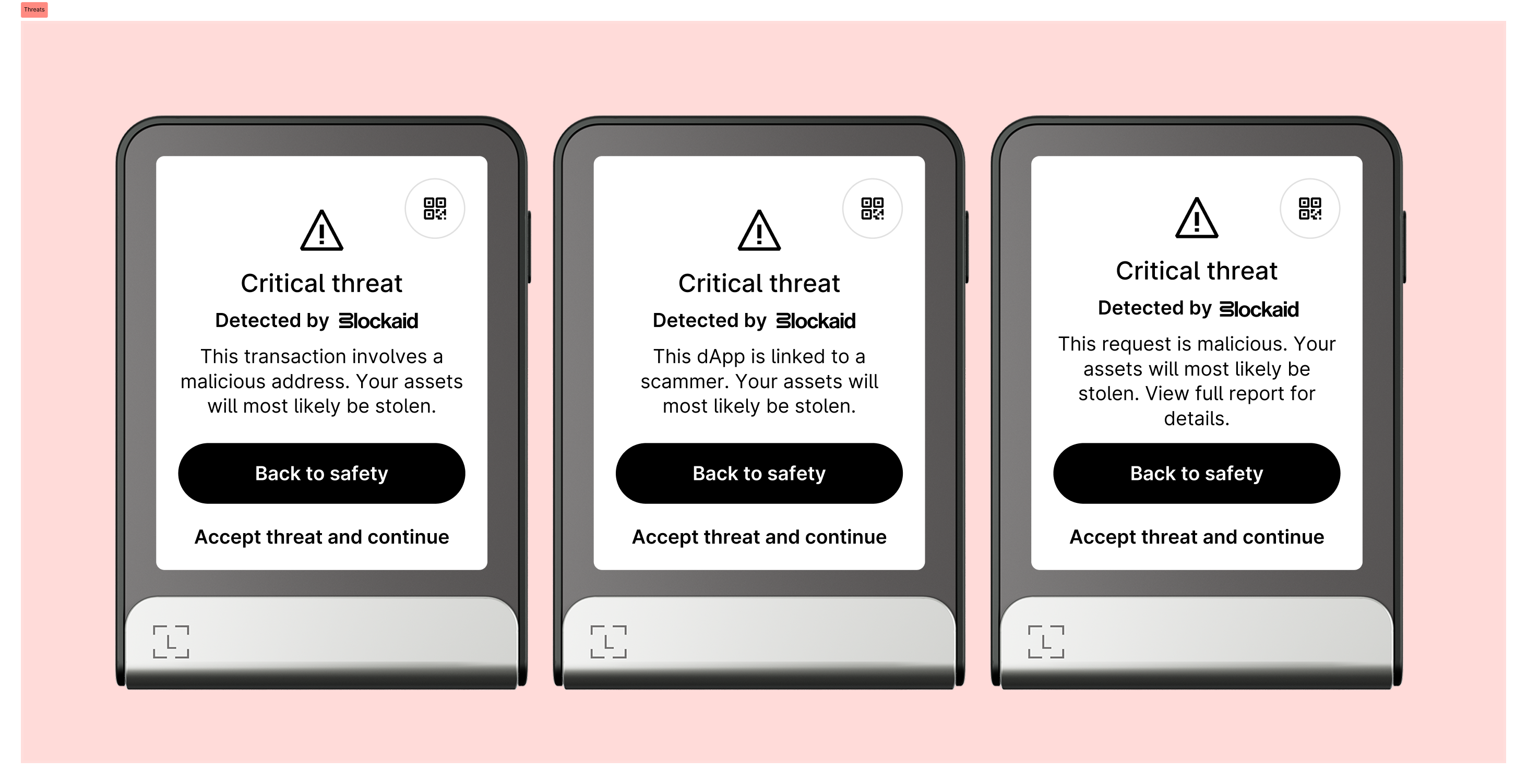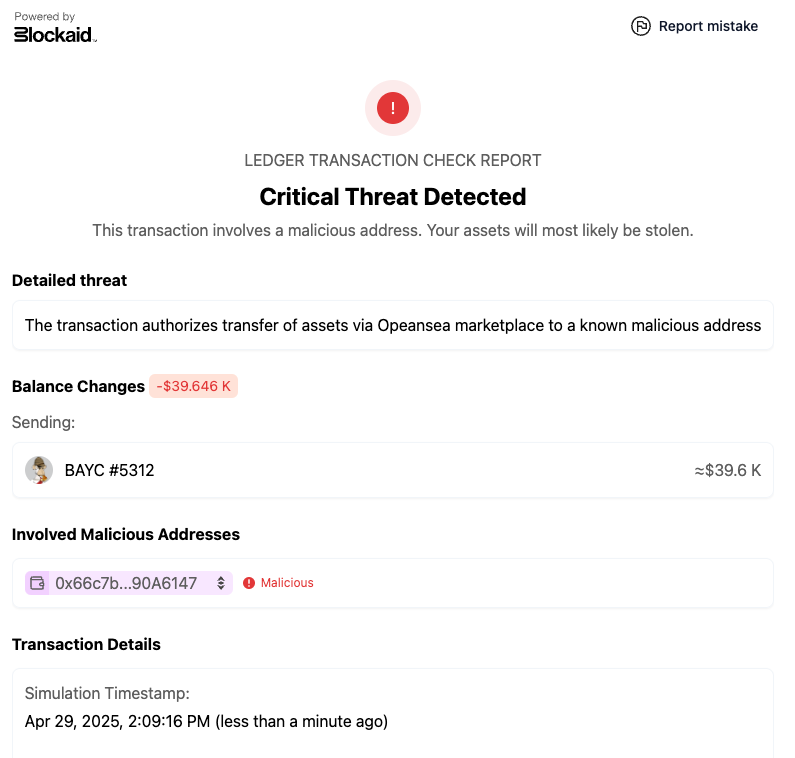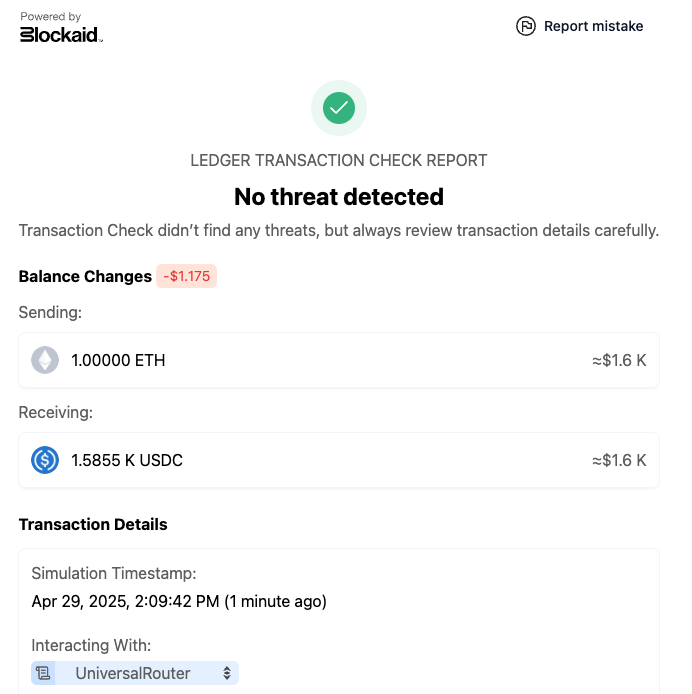How Blockaid Helps Ledger’s Transaction Check Mitigate Blind Signing Risks
.png&w=3840&q=100)
Today, Ledger is launching a new feature called Transaction Check, representing an important step in hardware wallet security, leveraging the Blockaid Transaction Security Engine among other technology providers for unprecedented on-device transaction clarity.
Transaction Check brings something truly valuable: a way to check their transactions for known threats, in real time, before approving the transaction.
When a user initiates an Ethereum transaction in Ledger Live, the user will be prompted to enable Transaction Check. The transaction is then first sent to trusted simulation providers for real-time analysis. Blockaid helps power this process, simulating transactions, validating outcomes, and identifying threats in real time with sub-300ms latency.
Then, a cryptographically signed summary of the result is delivered directly to the Ledger device, where the user sees a clear warning or a green light, with a link to the full security report.

With Transaction Check, Ledger users now benefit from the same real-time simulation technology already trusted by MetaMask, Coinbase, Backpack, Uniswap, and other leading wallets.
The result? Safer decisions, greater clarity, and far fewer chances to make irreversible mistakes.
The problem: attackers exploit the gap between signing interfaces and hardware wallets
There’s a built-in assumption in most signing flows: that the transaction you review in your wallet app or on your phone or desktop is the same one that gets signed on your hardware device.
But that assumption is fragile.
In a typical flow, users see transaction details in the signing interface - a browser extension or a mobile app. Then, the transaction is sent to the hardware wallet for approval.
However, this flow introduces a critical gap - which is being exploited by attackers.
In incidents like Bybit, WazirX, and Radiant, attackers manipulated transaction data in transit, replacing the user’s intended action with malicious logic, without changing what was shown on-screen. Users were left with no way to detect the switch until it was too late.
This issue is what’s known as blind signing, and it’s become one of the most dangerous vulnerabilities in the Web3 signing stack.
Blockaid had already built Cosigner to help organizations eliminate this risk in multisig and contract-level approvals.
Now, our commitment to closing the blind signing gap is extending to everyday users through a new collaboration with Ledger.
Meet Transaction Check: Verifiable security, built into the signing flow
Transaction Check is a new feature available for Ledger users that aims to reduce the risks of blind signing, directly addressing the gap between the signing interface and Ledger’s hardware wallets.
When a user is about to sign an Ethereum transaction in Ledger Live, the transaction is first simulated and validated by security providers like Blockaid, using the same technology already trusted by platforms like MetaMask, Coinbase, and 1inch.
Our engine simulates the transaction, validates its outcomes, and identifies known threats in real time, with unmatched precision and sub-300ms latency.
Then, a cryptographically signed summary of that result, specifically the warning or risk information, is sent directly to the user’s Ledger hardware wallet. This is the same approach introduced in the Blockaid Transaction Verification Whitepaper.
On-device, the user sees a clear message:
- If it’s flagged as a Critical Threat, the transaction likely involves a scam, malicious contract, or stolen funds.
- If it’s a Potential Risk, there may be suspicious components, such as interacting with a questionable dApp or sending assets to an unknown address.
This is real-time, verifiable insight delivered to the one place users can trust most: their Ledger device. There’s no longer a need to rely on frontend interfaces alone. Ledger now provides tamper-resistant confirmation of what’s being signed.
And if a user wants more context, each alert includes a link or QR code to a full simulation report, showing exactly what the transaction would do and why it was flagged.

What it means for the ecosystem
Transaction Check is more than just a product release, it’s a milestone for onchain security UX.
What used to require manual hash comparisons is now embedded directly into the signing flow and presented in a way that any user, from DeFi-native to first-time wallet owner, can understand and act on.
By leveraging transaction security technologies like Blockaid’s, Ledger offers a system that delivers enterprise-grade simulation, without ever compromising the simplicity that Ledger users expect.
Transaction Check’s launch reinforces how hardware-backed security needs to come with interface-level clarity. This is a model for how the ecosystem moves forward: more transparency, more verification, fewer compromises.

Recap: Reducing blind signing risk, one layer at a time
Transaction Check is a meaningful step forward in closing a critical gap in the transaction signing flow. It doesn’t eliminate blind signing entirely, but it significantly reduces the risk, by giving more control to hardware wallet users.
For Blockaid, this initiative is part of a broader effort to address blind signing at every layer.
With Cosigner, we built infrastructure for organizations to apply policy-based controls at the signature level, making sure that even in complex multisig environments, no transaction is approved without validation.
Now, with Ledger’s launch of Transaction Check, powered in part by Blockaid, we’re extending that same principle to the individual user: making sure the transaction they see is the one that gets signed.
Blockaid is helping power the simulation and validation engine behind Transaction Check, using the same infrastructure already securing millions of users across MetaMask, Coinbase, and other platforms.
The result: a cryptographically verifiable signal delivered straight to the hardware wallet, so users don’t have to rely on the interface alone. One more attack path closed. One more reason bad actors think twice.
Try it today
Transaction Check is available today on Ledger Stax and Ledger Flex devices for Ethereum transactions in Ledger Live.
Users can activate it by updating their Ledger Live app and Ledger OS.
Blockaid is securing the biggest companies operating onchain
Get in touch to learn how Blockaid helps teams secure their infrastructure, operations, and users.




